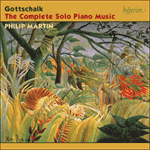The exact date of this brilliant and taxing piece is uncertain—either Paris 1850 or, more likely, New York 1855. In either case, Gottschalk never wrote it down and left it to his friend Espadero to issue the work posthumously in his own edition. Gottschalk was evidently taken by the music of the Belgian harpist Dieudonné Joseph Guillaume Félix Godefroid (1818–1897, whose brother Jules Joseph, 1811–1840, was also a noted harp player). Not only did he transcribe this popular harp solo (
Danse des sylphes is Godefroid’s Op 31) but also
Le Rêve (now lost), Godefroid’s
Étude mélodique, Op 23, and
La mélancolie, étude caractéristique, Op 24 (Gottschalk’s version appears as 167 in the RO catalogue, published in 1848 as ‘after F Godefroid’). The Caprice (in A flat) is a compendium of favourite Gottschalkian devices—scintillating runs at the top of the keyboard, passages for alternating hands, rapid repeated-note sections—a score to which Espadero adds liberal dashings of veloce e deciso and con impeto.
from notes by Jeremy Nicholas © 2003
On ne sait pas exactement quand cette pièce brillante et exigeante a été composée: soit à Paris en 1850, soit, plus probablement, à New York en 1855. Quoi qu’il en soit, Gottschalk ne l’a jamais notée par écrit, laissant à son ami Espadero le soin de la faire paraître à titre posthume, dans sa propre édition. Gottschalk a de toute évidence été séduit par la musique du harpiste belge Dieudonné Joseph Guillaume Félix Godefroid (1818–1897, dont le frère Jules Joseph, 1811–1840, était aussi un harpiste renommé). Il a non seulement transcrit ce solo de harpe populaire (
Danse des sylphes est l’opus 31 de Godefroid), mais aussi
Le Rêve (aujourd’hui perdu), l’
Étude mélodique, op. 23, et
La mélancolie, étude caractéristique, op. 24 (la version de Gottschalk porte la référence 167 dans le catalogue RO, et est donnée comme publiée en 1848, «d’après F. Godefroid»). Le présent Caprice (en la bémol) est un abrégé des procédés favoris de Gottschalk—gammes étincelantes dans l’aigu du clavier, passages pour mains alternées, sections rapides en notes répétées—, une partition qu’Espadero émaille libéralement de veloce e deciso et de con impeto.
extrait des notes rédigées par Jeremy Nicholas © 2003
Français: Josée Bégaud
Das genaue Entstehungsdatum dieses brillanten und anspruchsvollen Stückes ist ungewiss—entweder entstand es in Paris im Jahre 1850 oder, was wahrscheinlicher ist, in New York 1855. Wie dem auch sei, Gottschalk notierte es nie, sondern hinterließ es seinem Freund Espadero, der es in seiner Ausgabe nach dem Tode Gottschalks veröffentlichte. Gottschalk war offenbar sehr beeindruckt von den Werken des belgischen Harfenisten Dieudonné Joseph Guillaume Félix Godefroid (1818–1897, dessen Bruder Jules Joseph, 1811–1840, war ebenfalls ein anerkannter Harfenspieler). Er bearbeitete nicht nur dieses populäre Harfensolo (
Danse des sylphes ist Godefroids Op. 31), sondern auch
Le Rêve (heute verschollen), Godefroids
Étude melodique, Op.23, sowie
La Mélancolie, étude charactéristique, Op. 24 (Gottschalks Fassung erscheint als Nr. 167 im RO-Katalog, herausgegeben 1848 als „nach F. Godefroid“). Das Caprice (in As-Dur) ist ein Kompendium der Lieblingsstilmittel Gottschalks—sprühende Läufe in den hohen Lagen der Klaviatur, Passagen für alternierende Hände, schnelle Tonrepetitionen—ein Notentext, das Espadero großzügig mit veloce e deciso und con impeto würzt.
aus dem Begleittext von Jeremy Nicholas © 2003
Deutsch: Viola Scheffel


 Gottschalk: The Complete Solo Piano Music
Gottschalk: The Complete Solo Piano Music
